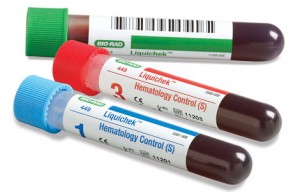Consultant Libby Knollmeyer’s Lab Machine Primer Series Part 1: Hematology Analyzers
 When laboratories in physician offices move out of the Waived category into the Moderately Complex category, it is usually because they want to acquire the capability of testing CBCs (Complete Blood Counts). To date, there are no waived hematology analyzers, so to do CBCs in-office, the lab must be at least of moderate complexity.
When laboratories in physician offices move out of the Waived category into the Moderately Complex category, it is usually because they want to acquire the capability of testing CBCs (Complete Blood Counts). To date, there are no waived hematology analyzers, so to do CBCs in-office, the lab must be at least of moderate complexity.
The major difference between Waived and Moderate Complexity labs is that there is regulatory oversight for all non-waived labs (moderate and high complexity), as well as requirements for lab directors, testing personnel, proficiency testing, and biannual inspections that are not present for Waived labs, which all add to the cost of having a laboratory.
In general, however, CBCs are a profit-generating test and virtually every medical specialty can make use of hematological testing information. A single physician practice can generate a profit performing a minimum of 5 CBCs/day, even with the added financial burdens of having a non-waived laboratory. Preforming CBC tests is a great low-impact way to add revenue to your medical practice with diagnostic medical equipment.
The hematology analyzer analyzes whole blood and counts or calculates the following parameters:
- WBC (white blood count)
- Automated WBC Differential
- RBC (red blood count)
- Hemoglobin
- Hematocrit
- MCV (average red blood cell size)
- MCH (hemoglobin amount per red blood cell)
- MCHC (RBC indices of size and hemoglobin concentration)
- Platelets
- MPV (Mean Platelet Volume)
The list of diagnosis codes that support medical necessity is so long that only the excluded codes are listed in the National Coverage Determination guidelines. All the hematology analyzers suitable for a POL are moderately complex and therefore require only a high school diploma and the approval of the lab director for testing personnel.
There are two types of hematology analyzers in common use today: the 3-part differential analyzer and the 5-part differential analyzer.
In a 5-part diff, all 5 types of WBCs are differentiated in the counting: neutrophils, eosinophils, basophils, lymphocytes, and monocytes.
In the 3-part diff the granulocytes (neutrophils, eosinophils, and basophils) are grouped into one category rather than being counted individually. The cells in a 3-part differential are reported as GRAN, MID, and LYMPH. In both types of analyzers, counts of WBC cell types are reported as both percentages and absolute numbers, with the absolute number being calculated by multiplying the percentage times the total WBC count.
What are the differences between the two types of analyzers?
Other than the differentials there is basically little difference in the two types of analyzers. They all count all the parameters in a CBC. Some of the more sophisticated instruments count reticulocytes (a form of RBC), but this capability is seldom needed in the Physician Office Lab (POL) setting.
The analyzers differ from one another primarily by test volume capability (which greatly influences the size), mode of introduction of sample into the analyzer (individually or with an autoloader), by method of determining the automated differential, and most notably by cost.
How do you get test results into the EMR?
Most analyzers (regardless of what tests they perform) do not have the capability of depositing results directly into an EMR and require either a laboratory information system (LIS) or a middleware component (of which there are several available) to transport the data to the EMR. This is because most analyzers produce data in ASCII or ASTM files and the EMRs accept data in HL-7 format.
There are hematology analyzers that come with a small LIS or middleware solution. Some practices have tried manual input of data into the EMR, but this is both fraught with significant error and time consuming. By the time an employee is paid to enter the data in a busy practice, a middleware solution could have been put into place and money saved over time. The other option would be to scan the report into the EMR, but this is also time-consuming. In the end, a middleware solution or inexpensive LIS resolves the issue less expensively than any manual process, and with far less error.
How much room does an analyzer take in a lab?
The size of hematology analyzers ranges from about the size of 2 shoeboxes stacked to 3 feet or more in width, but for the POL, the size is generally small and the analyzer will usually fit on a counter with no more than 1.5 to 2 feet of space required. The only environmental condition requirements are room temperature and humidity and the acceptable range for each is quite wide. Having environmental requirements, while they are easy to meet, requires that room temperature and room humidity be monitored and recorded on each day of patient testing, but a simple room thermometer with hygrometer (available at most hardware stores) will suffice for this.
What does a lab analyzer cost?
3-part diff analyzers are invariably less expensive ($9,000 – $20,000 on average) than 5-part diff analyzers ($30,000 to more than 6 figures)—both to obtain as well as to operate and maintain.
What consumable supplies are used in analyzers?
All analyzers require reagents for operation (at a minimum a saline diluent and a lysing reagent which gets rid of red cells when white cells are being counted) as well as quality control materials (tested daily) and calibrators (tested twice a year). The 5-part diff analyzers also require additional reagents and stains for the diff, which increases the cost of operation significantly. In reality, most of the time the enumeration of the eosinophils and basophils separately isn’t of great importance to maintaining the care of the patient, so physicians should carefully assess their need for this information before purchasing an analyzer. The difference in cost from a 3-part diff to a 5-part diff can be tens of thousands of dollars per year.
How do you choose one analyzer over another?
Regardless of the size and type of analyzer an office is considering, it is imperative to do the due diligence and call a users list to determine how reliable the instrument being considered is, how easy it is to operate and maintain, and most importantly, the question is “would you purchase this analyzer again?”
 Consultant Elizabeth “Libby” Knollmeyer, B.S., MT (ASCP) has over 40 years experience in the laboratory industry and has set up many laboratories! She specializes in financial, operational management and compliance issues for both hospital and physician office laboratories. Libby has a wide variety of experience with her areas of special expertise including financial review and management, Quality Management protocols, outreach development, compliance and regulatory assistance, lab design and up fitting, lab remodeling, and market research for IVD manufacturers. She works independently and with large consulting groups to provide interim management for hospitals, and serves as adviser to lab equipment and supply distributors. She consults (and enjoys traveling) throughout the US and internationally. She can be reached at (336) 288-5823 or at eknollmeyer@triad.rr.com.
Consultant Elizabeth “Libby” Knollmeyer, B.S., MT (ASCP) has over 40 years experience in the laboratory industry and has set up many laboratories! She specializes in financial, operational management and compliance issues for both hospital and physician office laboratories. Libby has a wide variety of experience with her areas of special expertise including financial review and management, Quality Management protocols, outreach development, compliance and regulatory assistance, lab design and up fitting, lab remodeling, and market research for IVD manufacturers. She works independently and with large consulting groups to provide interim management for hospitals, and serves as adviser to lab equipment and supply distributors. She consults (and enjoys traveling) throughout the US and internationally. She can be reached at (336) 288-5823 or at eknollmeyer@triad.rr.com.

